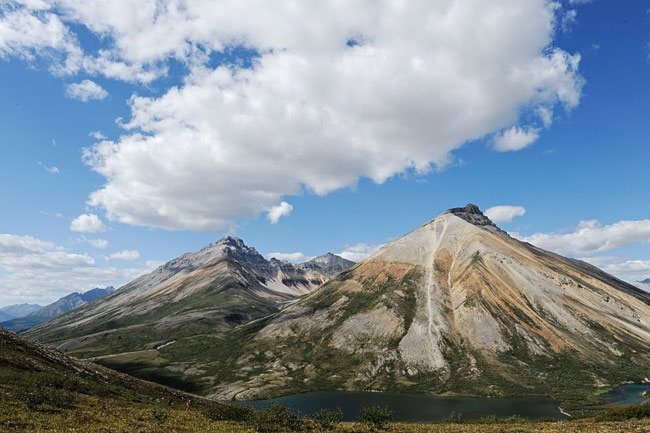INUVIK
If 90-year-old Eunice Mitchell had been given a chance to speak, she would have asked about the mess left behind by oil companies at the Peel’s Caribou River.
“I was too slow,” said the bespectacled elder with a little grin as she watched Yukon government officials tear down the maps they’d tacked to the meeting room walls for the Peel land-use plan consultation Wednesday.
But she wasn’t too slow at all - organizers didn’t give her, or the other 15 participants, fair warning they were going to wrap things up.
Instead, the aging granny was told, after the fact, she’d get another chance to talk when the Peel roadshow arrives in her home community of Fort McPherson in two weeks time.
Even though she didn’t get to say her bit, Mitchell was still glad she came. She says it made her happy to hear people say so many good things about the Peel.
People, like James Firth, who used the Caribou River contaminated site as an illustration of how governments need to co-operate more closely if land use planning is going to work.
The Gwich’in had to fight long and hard to get some action on that site, he said.
“For over three years they were going up with shovels and garbage bags and hauling it out and that’s not acceptable,” Firth said.
Eventually it was cleaned up, but many other sites still remain.
Robert Charlie, who grew up on the Peel River and supports full protection for the watershed, says the issue of contaminated sites is part of a larger problem.
“I don’t know who is responsible for cleaning those up, but we have a land claims agreement that was settled in 1992 and part of the conditions in that document are that those sites are supposed to be cleaned up,” Charlie said.
“If that’s any indication on how that land is going to be protected, I don’t have any faith in government to take care of that land for us.”
The Yukon government needs to make a plan to remediate all the contaminated sites in the Peel planning area, said Norman Snowshoe.
“To ensure there is no Caribou River all over again,” he said.
Tetlit Gwich’in elder Charlie Snowshoe, who has been fighting to protect the Peel watershed since the 1980s, raised concerns about existing mineral claims.
He’s angry that most of the 8,000 or so Peel claims were staked during the land-use planning process after the government refused to impose a moratorium.
And he’s angry that once it finally issued a one-year staking ban last February, it then decided to automatically renew 2,400 claims due to expire during the ban, for free.
“What’s going on?” asked Snowshoe point blank.
Nor can he understand why the existing claims have been “grandfathered in” under the recommended plan.
“It (claim staking) shouldn’t have happened at the time they were working on the land-use planning. Five years and they were still staking claims. When you classify it (now) as a grandfathered deal, that’s not right,” he said.
Yukon government planner Renee Mayes pinned the blame for the grandfathered claims on the Peel Watershed Planning Commission.
“That (grandfathering the claims) was a recommendation that the commission, an independent body, has made to the governments. The claims have a legal basis for their existence. We haven’t explored extinguishing them and I guess the commission didn’t either because they have not recommended that,” she said.
What she failed to mention was the Yukon government didn’t give the commission any choice - it said it would not expropriate any claims or compensate claim holders.
Just who owns all these claims and what do they pay for them, Inuvik elder Liz Hansen wanted to know.
“The answers to those questions is available on the government of Yukon’s website,” said Mayes without giving any other details, such as a web address.
After Hansen pointed out that many people don’t know how to use the internet or even have access to it, Mayes agreed to have the information sent to her by mail.
That’s a good thing because even for those with a computer, an internet connection and the knowledge to use them coaxing information from the government’s mining claims database is a major challenge.
There is no way to ask for only claims in the Peel planning region. Without a company name, a claim name or a location, conducting such a search is almost impossible.
Nor does the site include any information about the money paid or work done on the claims.
Just as an aside, the controversial video, produced by the Na-cho Nyak Dun and Tr’ondek Hwech’in, was sent back down to the bottom of the agenda.
At the last meeting in Dawson City, Chief Eddie Taylor managed to persuade government officials to play the video that gives a First Nations perspective shortly after the meeting started.
Next week the Peel meetings move to Whitehorse. There will be an information session on September 13 and a public meeting on September 15 at the Yukon Inn.
Meetings will also be held in Fort McPherson, Tsiigehtchic and Mayo before the consultation period ends on October 1.
Yukon writer Mary Walden is doing a series of stories on the consultation meetings. The former CBC journalist and Yukon News editor also co-owns a wilderness tourism company that does canoe trips in the region. You can read more stories at peelwatershed.blogspot.com.
